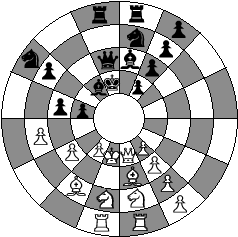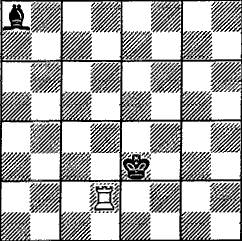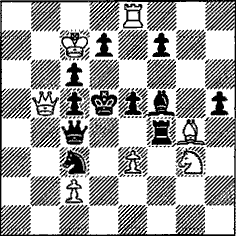Variant Chess Index
|
The magazine to broaden your chess horizons
|
Contents
|
ReviewMore Flights of Chess Fancy This is a well produced booklet of 28 pages by John Beasley containing 25 more examples of his lateral thinking - problems, puzzles and jokes. The booklet is bilingual, Czech and English text being set down side by side. Slip it into your pocket and take it on your next train journey: the time will pass more quickly than you expected. Readers of Variant Chess and British Endgame Study News will receive a complimentary copy. Please note that the book is otherwise not available for sale from John himself. Published by
also available from British Chess Magazine
|
||||||||||||||||||||||||||
|
CIRCULAR CHESS
by John Beasley This year's Circular Chess World Championship was held at St Mary's Guildhall, Lincoln, on Sunday May 14. Our apologies to at least one reader who had intended to spectate and went to the main Guildhall as wrongly advertised in VC 34. Those who entered received instructions giving the correct venue, but we failed to realise that there might be others who wanted to be present.
The board for this game consists of four concentric rings as shown diagrammatically above (assume the a and h files joined end to end to form one 16-square ring, the b and g files joined similarly, and so on). Moves are as normal, so if the board were empty bRa8 would command the whole a/h ring and also b8/c8/d8, bNb8 would command e8/f7/h7 as well as its normal squares a6/c6/d7, bBc8 would command e8/g8/h7 as well as b7/a6/d7, and bKd8 would command c7/d7/c8/e8/f8. There is no castling, and no en passant. In each of the previous three years the championship had been won by Francis Bowers, but this year saw a new champion in the shape of Herman Kok. Herman, his competitive skills honed long ago by playing blitz in the cafes of Amsterdam to supplement a student grant, won a five-round Swiss in excellent style, dropping a mere half point and beating both the runners-up (Francis and Paul Byway, 4 points each). Your correspondent displayed street wisdom of a different kind: faced with a lengthy but inevitable
loss in the last game of the
|
morning session, he resigned at once, gaining a reputation for gentlemanly behaviour and ensuring that he was at the front of the lunch queue. During his years of triumph, Francis acquired a reputation for surviving hopelessly lost positions and getting out of impossibly tight corners. This year, his opponent gave him no such chance. White Black Francis Bowers Herman Kok 1. a2-a4 d7-d5 2. b2-b4 Bc8-d7 3. a4-a5 Nb8-a6 4. Bc1-a3 b7-b6 5. a5xb6
The aggressive long-term option for Black is now ...cxb6, giving each player a half-open ring on which to deploy his major pieces. Which would be the stronger: White's possession of the a/h ring, on which his rooks are already doubled and Black's pawn is likely to become weak, or Black's of the more central c/f ring with its potentially more immediate threat to the opponent's king? This choice between side ring and inner ring is perhaps the most fundamental strategic question in the game, but it is not to be explored on this occasion because Black chooses 5. ... a7xb6 In the long term, this might be thought as tending to a draw; neither side can afford to concede control of the open ring, so exchanges will be inevitable, and once the rooks and queens are off the game would appear to favour the defence (the attacker has only a four-file front on which to operate, and the
|
defender can switch his pieces from wing to wing much more quickly than the attacker can). However, this is in the long term, and in the short term Black has pressure on the b-pawn. 6. c2-c3 Qe8-c8 7. Ba3-b2 c7-c5
Black clearly stands better, and a writer on development would point out that he has moved three pieces once each whereas White has moved one piece twice. But White's demise hardly seems imminent. 8. Ng1-c2 c5xb4 9. Nc2xb4? This loses at least a pawn. 9.cxb4 was correct. 9. Na6xb4 10. c3xb4?? And now 10.Rxa8 was essential.
10. Ra8xa1
11. Rh1xa1 Rh8xa1
12. Bb2xa1 Bd7-a4
mate
10.Rxa8 Rxa8 11.Rxa8 Qxa8 12.cxb4 would have saved mate, but 12...Qa4+ and 13...Qxb4 would still have left Black with much the better of it. |
|
PROBLEM PAGES by Ronald Turnbull 322: this is Grid Chess - another unplayable variant, as it's very hard to achieve anything at all, particularly mate. Only moves crossing one or more of the grid lines are legal - and this applies also to checks - apparent king-captures that don't cross grid-lines do not give check. In this diagram the K could legally stand on d1 or c2. On the other hand, he can never legally reach any of the corners. This is a seriesmover, where Black makes 7 successive legal moves (with White not moving at all) in such a way that White can then deliver checkmate. There are two ways to do this. Each sequence of moves will be unique - for problemists, it spoils it completely if Black's moves can be swapped about a bit. Again, this has one dagger for difficulty. However, if it's all totally perplexing, click here for an explanatory near-solution: * 322 - Ian RICHARDSON
Grid chess
|
324: is a fine way to disabuse anyone of the notion that chess problems have anything to do with chess play. 'No-capture Chess' means that all units, including Ks, lose their capturing powers - though they retain the power to give check. Each side can simply leave its king behind the game-array wall, adding redoubts to prevent knight-attacks, and then continue until one side resigns out of boredom... In the position diagrammed, if Black moves his Q, white can mate at once by Qc4. This problem is rated ONE DAGGER - only slightly difficult. 324 - Alex ETTINGER
No-capture chess, mate in 2 |
Selected articles from
Variant Chess appear here on the Chess Variant Pages with
the permission of the British Chess Variants Society (BCVS).
We feel that this journal is exceptional, and have entered into an
agreement with the BCVS to publish certain of their articles on our
pages in return for advertising.
| |







